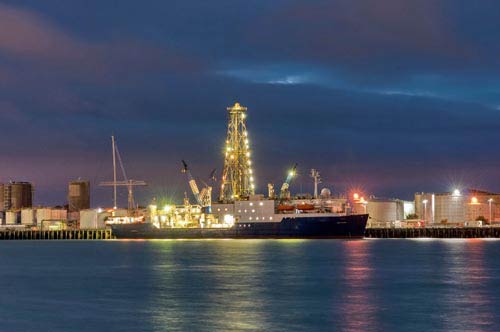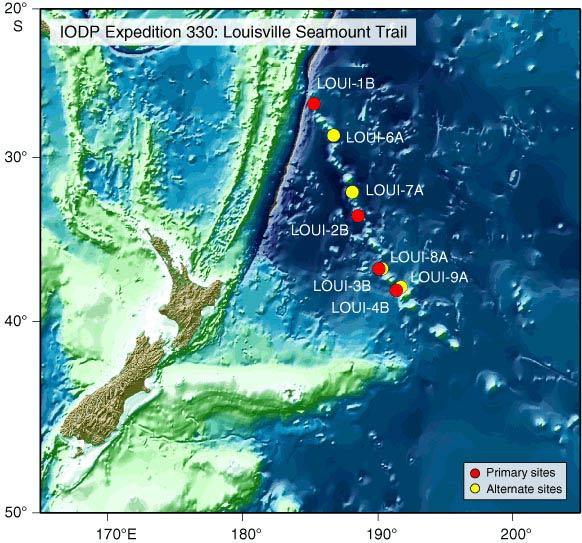Underwater Volcanoes a Hotbed of Clues to Earth's Movements


Nearly half a mile of rock retrieved from beneath the seafloor is yielding new clues about how underwater volcanoes are created and whether the underlying hot spots of molten rock that lead to their formation have moved over time.
Geoscientists have just completed an expedition, part of the Integrated Ocean Drilling Program (IODP), to a string of underwater volcanoes, or seamounts, in the Pacific Ocean known as the Louisville Seamount Trail.
There they collected samples of ocean floor sediments, lava flows and other volcanic eruption materials to piece together the history of this ancient trail of volcanoes, which formed from plumes of hot material found deep within the Earth that supply a steady stream of heated rock known as hot spots.
"Finding out whether hot spots in Earth's mantle are stationary or not will lead to new knowledge about the basic workings of our planet," said Rodey Batiza, section head for marine geosciences in the National Science Foundation's (NSF) Division of Ocean Sciences.
Seamount sampling
Tens of thousands of seamounts exist in the Pacific Ocean. Expedition scientists probed a handful of the most important of these underwater volcanoes, including the Louisville Trail.
"We sampled ancient lava flows, and a fossilized algal reef," said Anthony Koppers of Oregon State University. "The samples will be used to study the construction and evolution of individual volcanoes."
Get the world’s most fascinating discoveries delivered straight to your inbox.
Koppers led the expedition aboard the scientific research vessel JOIDES Resolution, along with co-chief scientist Toshitsugu Yamazaki from the Geological Survey of Japan at the National Institute of Advanced Industrial Science and Technology.
Over the last two months, scientists drilled 3,651 feet (1,113 meters) into the seafloor to recover 2,644 feet (806 meters) of volcanic rock.
The samples were retrieved from six sites at five seamounts ranging in age from 50 million to 80 million years old.
Tracking tectonic plates
Trails of volcanoes found in the middle of tectonic plates, such as the Hawaii-Emperor and Louisville Seamount trails, are believed to form from hot spots.
As a tectonic plate (a large slab of Earth's crust) drifts over a hot spot, new volcanoes are formed and old ones become extinct. Over time, a trail of volcanoesis formed. The Louisville Seamount Trail is some 2,600 miles (4,300 kilometers) long.
"Submarine volcanic trails like the Louisville Seamount Trail are unique because they record the direction and speed at which tectonic plates move," Koppers said.
Scientists use these volcanoes to study the motion of tectonic plates, comparing the ages of the volcanoes against their location over time to calculate the rate at which a plate moved over a hotspot.
These calculations assume the hot spot stays in the same place.
"The challenge," Koppers said, "is that no one knows if hot spots are truly stationary or if they somehow wander over time. If they wander, then our calculations of plate direction and speed need to be re-evaluated."
Earth's interior
And that's not all that scientists might learn from the rock they've retrieved.
"More importantly, the results of this expedition will give us a more accurate picture of the dynamic nature of the interior of the Earth on a planetary scale," Koppers said.
Recent studies in Hawaii have shown that the Hawaii hot spotmay have moved as much as 1,000 miles (1,600 kilometers) over a period of 30 million years.
"We want to know if the Louisville hot spot moved at the same time and in the same direction as the Hawaiian hot spot. Our models suggest that it's the opposite, but we won't really know until we analyze the samples from this expedition," Yamazaki said.




